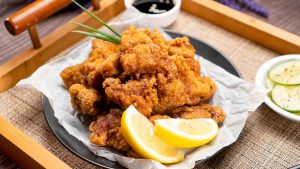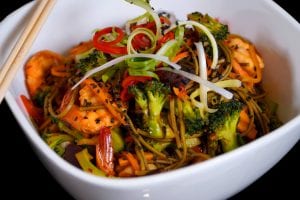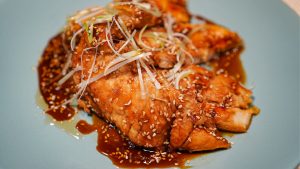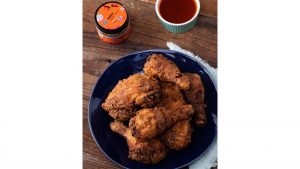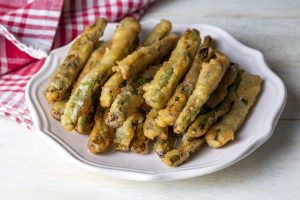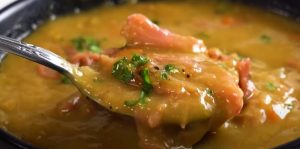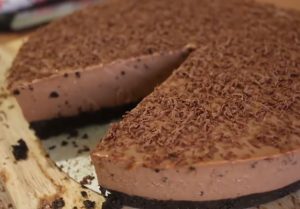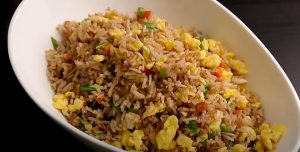Pan-fried noodles are a classic staple of Asian cuisine, known for their versatility, delightful texture, and the delicious flavors they absorb from the ingredients they're cooked with. This recipe elevates those qualities by using a variety of fresh and vibrant ingredients that bring out the best in these noodles, creating a dish that's not only satisfying but also fun to prepare and serve.
Most of these ingredients can be found easily in your local grocery store. However, some like hoisin sauce, toasted sesame oil, and the specific type of noodles might require a trip to an Asian market or the international aisle of a well-stocked supermarket. Hoisin sauce adds a sweet and salty flavor that's hard to replicate with other ingredients. Toasted sesame oil, on the other hand, gives the dish a nutty flavor that complements the other ingredients beautifully.
Essential Ingredients for Pan-fried Noodles
Vegetable oil: Used for frying the noodles and vegetables to a perfect golden brown. Carrots: Adds a sweet flavor and crunchy texture. White onion: Gives a mild and sweet flavor. Green onions: Provides a crisp, tangy boost to the dish. Garlic: A flavor powerhouse that infuses the dish with its distinctive taste. Noodles: The star of the dish. They soak up the flavors and provide the 'body' of the dish. Soy sauce: Adds saltiness and a deep umami flavor. Hoisin sauce: Gives the dish a distinctive sweet-and-salty taste. Toasted sesame oil: Adds a toasty, nutty flavor. Cornstarch: Helps in thickening the sauce to coat the noodles better. Bean sprouts: Adds a crunchy texture and freshness. Sesame seeds: Gives a nice crunch and flavor. Additional green onions: For garnishing and added freshness.
One reader, Hank Archuleta says:





I recently tried the pan-fried noodles recipe and it was a game-changer! The combination of crispy noodles and flavorful veggies was a delight. The sauce was the perfect balance of savory and sweet. It's now my go-to dish for a quick and delicious meal. Highly recommend trying it out!
Techniques Required for Perfect Pan-Fried Noodles
How to pan-fry noodles: This technique involves frying noodles in a pan until they are crispy on the edges, adding a delightful texture to the dish.
How to prepare the sauce: This involves whisking together soy sauce, hoisin sauce, sesame oil, cornstarch, and water in a small bowl to create a flavorful sauce for the noodles.
How to wilt bean sprouts: This technique involves adding bean sprouts to the pan and cooking them until they are slightly softened and wilted.
How to garnish with sesame seeds and green onions: This involves sprinkling sesame seeds and green onions over the finished dish to add color, flavor, and texture.
Whenever I’m craving for an Asian noodle dish, I make this delicious vegetable pan-fried noodles recipe at home. It’s savory and subtly sweet, as it’s made with crispy noodles, chopped vegetables, and a delectable homemade sauce. I love making these Chinese fried noodles because every bite is just so yummy and filling to eat! What’s more, it’s so easy to make this Asian-style fried noodle dish since it’s cooked and stir-fried in one pan.
Pan-fried noodles, or Hong Kong-style pan-fried noodles to be specific, are also known as chow mein. This noodle dish comes with crunchy noodles that are “twice-browned” or cooked until golden on both sides. It’s different from the sauce-heavy lo mein dish that is served with soft and tender noodles. Both chow mein and lo mein are delicious, but I honestly prefer the texture of crispy fried noodles, especially when they’re coated with a thick Asian noodle sauce and covered in veggies.
The best noodles to use for this Chinese pan-fried noodles recipe are fresh Hong Kong-style ones. These thin, yellow, egg-based noodles are often used for this type of dish. If you can’t find some in your local Asian supermarkets, then you can also use either Japanese noodles like yakisoba or Chinese egg noodles as alternatives. I recommend using fresh noodles for pan-frying since they are precooked to make cooking easier and faster. Dried noodles also work, but you’ll need to boil them for about three minutes beforehand. With fresh noodles, I only had to soak them in water to loosen and separate them.
While soaking the noodles, I first heated the pan and cooked the vegetables until softened. Then, I took them out to separately fry the noodles. Make sure to brown and crisp the noodles on each side before combining them with the veggies. This will take a total of eight minutes.
As the noodles were cooking, I made the noodle sauce next. For this, I combined soy sauce, hoisin sauce, sesame oil, cornstarch, and water in a small bowl. I then poured the mixture into the noodles, along with the mung bean sprouts. Cook for a few more minutes until the sauce, noodles, and veggies are thoroughly combined.
Finally, I transferred the noodles into a bowl, and then garnished the dish with sesame seeds and additional green onions. If you want a bit of protein in your Hong Kong-style pan-fried noodles, then you can also add chicken, seafood, beef, or pork into the mix. I tried making Cantonese-style chicken pan-fried noodles before, and it also tasted delicious with the added chicken flavor. Pan-fried noodles with beef is also another popular variation that I’ve cooked at home. It was flavorful and tasty, although a tad spicier than what I made here.
Whichever you choose to make, all of these homemade Asian noodle dishes are equally delicious. And with my homemade noodle stir fry recipe, you won’t need to go to the nearest Chinese restaurant to enjoy a serving of their pan-fried noodles. Customize this crispy noodle dish according to your taste, and enjoy it whenever you like!
How To Make Pan Fried Noodles
These crispy pan-fried noodles are tossed with bean sprouts, carrots, and onions in a rich, savory sauce made with hoisin and sesame oil.
Serves:
Ingredients
- 1 tbsp vegetable oil, plus 2 tsp, divided
- 1 cup carrots, shredded
- ½ cup white onion, thinly sliced
- ½ cup green onions, cut into 1-inch pieces, thinly sliced lengthwise
- 2 tsp garlic, minced
- 12 oz noodles, fresh, like Hong Kong noodles or yakisoba, cooked
- ¼ cup soy sauce, low sodium
- 1 tbsp hoisin sauce
- 1 tbsp toasted sesame oil
- 2 tsp cornstarch
- 1 cup mung bean sprouts
- 1 tbsp sesame seeds
- green onions, thinly sliced, for garnish, optional
Instructions
- Heat 2 teaspoons of vegetable oil over medium-high heat in a large pan. Add the shredded carrots and white onions to the pan.
- Cook for 3 to 5 minutes, or until the vegetables are softened. Add the green onions and garlic, then cook for 30 seconds. Remove the vegetables from the pan, then cover to keep warm.
- Rinse the noodles under hot water to separate the pieces.
- Heat the remaining tablespoon of vegetable oil in the pan. Add the noodles, then cook for 3 to 4 minutes per side, or until browned and crispy on the edges.
- Add the vegetables back to the pan.
- In a small bowl, whisk together the soy sauce, hoisin sauce, sesame oil, cornstarch and 2 tablespoons of cold water.
- Add the bean sprouts to the pan, and toss to combine. Then, add the sauce to the pan and bring to a simmer.
- Cook for 2 to 3 minutes, or until the sauce has thickened and the mung bean sprouts have wilted.
- Sprinkle with sesame seeds and additional green onions, serve, and enjoy!
Recipe Notes
For the vegetables, feel free to add other types of veggies like broccoli, baby bok choy, baby corn, or snow peas so it’s even more filling and delicious.
Nutrition
- Calories: 457.19kcal
- Fat: 12.19g
- Saturated Fat: 1.94g
- Trans Fat: 0.08g
- Monounsaturated Fat: 5.43g
- Polyunsaturated Fat: 3.82g
- Carbohydrates: 72.62g
- Fiber: 5.34g
- Sugar: 6.43g
- Protein: 15.49g
- Cholesterol: 71.56mg
- Sodium: 983.92mg
- Calcium: 87.85mg
- Potassium: 497.83mg
- Iron: 4.59mg
- Vitamin A: 275.64µg
- Vitamin C: 9.51mg
Crucial Technique Tip for Pan-Fried Noodles
When pan-frying noodles, it's important to ensure that the pan is hot enough before adding the noodles. This will help achieve a nice, crispy texture on the edges. Also, remember to stir the noodles occasionally to prevent them from sticking to the pan. If you're using fresh noodles, you can skip the step of rinsing them under hot water. However, if you're using dried noodles, it's crucial to properly rehydrate them first by soaking in boiling water until they're al dente. Lastly, when adding the sauce, make sure to do it gradually while tossing the noodles to ensure they're evenly coated.
Time-Saving Tips for Making This Recipe
Prep ahead: Chop and prepare all the vegetables and sauces in advance to streamline the cooking process.
Organize ingredients: Arrange all the ingredients and utensils in an orderly manner before starting to cook for easy access and efficiency.
Use pre-cooked noodles: Save time by using pre-cooked or instant noodles instead of boiling fresh noodles from scratch.
Multi-task: While the noodles are cooking, prep the vegetables or make the sauce to maximize efficiency in the kitchen.
One-pan cooking: Opt for a large skillet or wok to cook the entire dish in one pan, reducing the number of dishes to clean up later.
Quick stir-fry: Increase the heat and stir-fry the ingredients quickly to achieve a delicious dish in a shorter amount of time.
Substitute Ingredients For Pan Fried Noodles Recipe
vegetable oil - Substitute with canola oil: Canola oil has a neutral flavor and a high smoke point, making it a suitable substitute for vegetable oil in pan-fried noodles.
white onion - Substitute with yellow onion: Yellow onions have a similar flavor profile to white onions and can be used as a substitute in this recipe.
garlic - Substitute with garlic powder: If fresh garlic is not available, garlic powder can be used as a substitute, although the flavor may be slightly different.
noodles - Substitute with spaghetti: Spaghetti can be used as a substitute for noodles in this recipe, providing a similar texture and taste.
soy sauce - Substitute with tamari: Tamari is a gluten-free alternative to soy sauce and can be used as a substitute in this recipe.
hoisin sauce - Substitute with plum sauce: Plum sauce can be used as a substitute for hoisin sauce, providing a sweet and tangy flavor to the dish.
toasted sesame oil - Substitute with peanut oil: Peanut oil can be used as a substitute for toasted sesame oil, adding a nutty flavor to the dish.
cornstarch - Substitute with arrowroot powder: Arrowroot powder can be used as a substitute for cornstarch to thicken the sauce in the recipe.
bean sprouts - Substitute with shredded cabbage: Shredded cabbage can be used as a substitute for bean sprouts, providing a similar crunchy texture.
sesame seeds - Substitute with chopped peanuts: Chopped peanuts can be used as a substitute for sesame seeds, adding a nutty flavor and crunch to the dish.
Presenting Pan-Fried Noodles for Maximum Appeal
Elevate the plating: As a chef aiming for Michelin-star presentation, pay attention to the visual appeal of the dish. Use edible flowers and microgreens to add vibrant colors and delicate textures to the plate.
Incorporate height and depth: Create a visually stunning plate by adding height and depth to the dish. Consider using crispy noodles to add a vertical element, and strategically place the stir-fried vegetables to create a sense of depth.
Focus on precision: Pay attention to the placement of each component on the plate. Use tweezers to delicately position the bean sprouts and sesame seeds for a meticulous presentation.
Emphasize balance and symmetry: Aim for a balanced and symmetrical arrangement of the noodles and vegetables. Create a harmonious composition by ensuring that each element complements the others in both flavor and appearance.
Highlight the sauce: Instead of mixing the sauce into the noodles, drizzle it artfully over the dish just before serving. This technique allows the vibrant colors of the vegetables and noodles to shine through while adding a glossy sheen to the presentation.
Use elegant tableware: Select elegant and minimalist tableware to showcase the dish. Consider using sleek, modern plates that provide a clean backdrop for the vibrant colors of the noodles and vegetables.
Garnish with finesse: Add a final touch of sophistication by garnishing the dish with thinly sliced green onions that have been meticulously curled and shaped, adding a touch of elegance to the presentation.
Essential Tools for Making Pan-Fried Noodles
- Large pan: A large, flat-bottomed pan used for frying and stir-frying the noodles and vegetables.
- Small bowl: Used for whisking together the sauce ingredients before adding to the pan.
- Tongs: Used for flipping and tossing the noodles while they are being pan-fried.
- Whisk: Used for mixing the sauce ingredients until smooth and well combined.
- Spatula: Used for stirring and tossing the noodles and vegetables in the pan.
- Knife: Used for chopping the carrots, onions, and green onions.
Storing and Freezing Pan-Fried Noodles
- Let the pan-fried noodles cool completely before storing them in an airtight container. They will keep in the refrigerator for up to 3-4 days.
- To reheat, simply place the noodles in a pan with a splash of water or chicken broth and heat over medium heat until warmed through.
- For longer storage, you can freeze the noodles in a freezer-safe container for up to 2-3 months. To prevent the noodles from sticking together, toss them with a bit of oil before freezing.
- When you're ready to enjoy the frozen noodles, thaw them in the refrigerator overnight and then reheat them in a pan with a little bit of liquid until they're heated through and the sauce is bubbling.
- If you find that the noodles have absorbed too much of the sauce during storage, you can add a splash of soy sauce or hoisin sauce when reheating to bring back the flavor.
How To Reheat Leftover Pan-Fried Noodles
Reheat in a skillet or wok: place the leftover noodles in a skillet or wok over medium heat. Add a small amount of oil or water to prevent sticking and to help revive the texture of the noodles. Stir frequently until heated through, about 3-5 minutes. This method helps to maintain the crispy texture of the pan-fried noodles.
Microwave reheating: place the leftover noodles in a microwave-safe dish and add a small amount of water or broth to help moisten the noodles. Cover the dish with a damp paper towel or microwave-safe lid. Microwave on high for 1-2 minutes, stirring halfway through, until heated through. This method is quick and convenient, but the noodles may lose some of their crispy texture.
Oven reheating: preheat the oven to 350°F (175°C). Spread the leftover noodles on a baking sheet and drizzle with a small amount of oil or broth. Cover the baking sheet with aluminum foil and bake for 10-15 minutes, or until heated through. Remove the foil for the last 2-3 minutes of reheating to help crisp up the noodles.
Steaming: place the leftover noodles in a steamer basket over boiling water. Steam for 2-3 minutes, or until heated through. This method helps to maintain the moisture in the noodles and is a healthier option as it doesn't require additional oil.
Stir-frying: heat a small amount of oil in a skillet or wok over medium-high heat. Add the leftover noodles and stir-fry for 2-3 minutes, or until heated through. You can also add additional vegetables or proteins to create a new dish using the leftover noodles as a base.
Fascinating Fact About Pan-Fried Noodles
Pan-fried noodles are a popular dish in many Asian cuisines, and they are often enjoyed as a quick and flavorful meal. They can be customized with a variety of vegetables, proteins, and sauces to suit individual tastes and preferences.
Is Making Pan-Fried Noodles at Home Cost-Effective?
This pan-fried noodles recipe is quite cost-effective for a household. The ingredients, such as vegetable oil, carrots, onions, and noodles, are affordable and readily available. The dish offers a satisfying portion size, making it suitable for a family meal. The total cost for a household of 4 people is approximately $10-$15, depending on the availability and quality of the ingredients. The versatility of this recipe allows for variations, making it a practical and economical choice for home cooking. Overall Verdict: 8.
Is This Dish Healthy or Unhealthy?
This pan-fried noodles recipe has both healthy and unhealthy aspects. On the positive side, it includes a variety of vegetables such as carrots, onions, garlic, and bean sprouts, which provide essential vitamins, minerals, and fiber. The use of sesame oil and seeds adds a dose of healthy fats and a nutty flavor. However, the recipe also contains some less healthy components. The soy sauce and hoisin sauce are high in sodium, which can be a concern for those watching their salt intake. Additionally, the noodles are likely refined carbohydrates, which may not be the most nutritious choice.
To make this recipe healthier, consider the following suggestions:
- Use whole wheat or buckwheat noodles instead of refined noodles to increase the fiber content and nutritional value
- Reduce the amount of soy sauce and hoisin sauce used, or opt for low-sodium versions to cut down on the salt content
- Add more vegetables to the dish, such as bell peppers, mushrooms, or bok choy, to boost the nutrient density
- Use a lean protein source like tofu, shrimp, or chicken to make the meal more balanced and satisfying
- Experiment with different herbs and spices, such as ginger or red pepper flakes, to add flavor without relying on high-sodium sauces
Editor's Opinion on Pan-Fried Noodles
This pan-fried noodles recipe offers a delightful combination of textures and flavors. The use of a variety of vegetables adds a colorful and nutritious element to the dish, while the crispy edges of the noodles provide a satisfying crunch. The savory and slightly sweet sauce ties everything together beautifully, creating a harmonious balance of tastes. The addition of sesame seeds adds a lovely nuttiness, enhancing the overall appeal of the dish. This recipe is a wonderful choice for a quick and flavorful meal that is sure to please the palate.
Enhance Your Pan Fried Noodles Recipe with These Unique Side Dishes:
Similar Recipes to Try If You Love Pan-Fried Noodles
Appetizers and Desserts to Complement Your Pan-Fried Noodles
Why trust this Pan Fried Noodles Recipe:
This recipe offers a delightful combination of fresh vegetables and savory noodles, creating a harmonious blend of flavors and textures. The use of soy sauce and hoisin sauce infuses the dish with rich umami notes, while the addition of sesame oil and sesame seeds provides a delightful nuttiness. The careful preparation and cooking techniques ensure that the noodles are perfectly crispy and golden, adding a satisfying crunch to each bite. With its balanced flavors and expertly chosen ingredients, this recipe promises a delightful dining experience for all food enthusiasts.
Was this page helpful?
Have your own special recipe to share? Submit Your Recipe Today!

